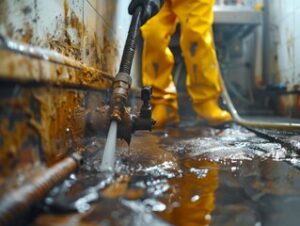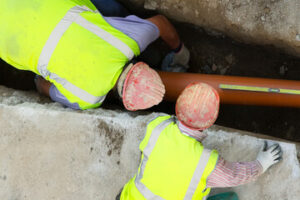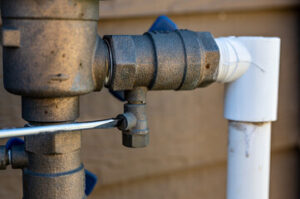Plumbing Jobs – Learn the Basics of Septic Systems and Sewage Treatment Systems
Rosenberg Plumbing is one of the most skilled trades, and it requires a strong combination of hard and soft skills. If you like working with your hands, have good problem-solving abilities, and can follow instructions, then this may be the right career for you.

Most people think of drains when they hear the word “plumbing.” However, there are several other important components to the plumbing system of any building.
More than one in every household uses a private septic system, cluster system, or on-site wastewater treatment system to dispose of household wastewater. These decentralized sewage treatment systems are vital to keeping homes sanitary and safeguarding local water quality. However, when not used and maintained properly, septic systems can fail. Understanding how your septic system works can help you avoid these problems and keep your home safe, healthy and environmentally friendly.
Wastewater from toilets, showers and sink drains flows into the septic tank, where it collects until there are enough solids to be removed by the bacteria that live in the septic system. As a result, wastewater leaves the tank as liquid effluent. This liquid flows out of the septic tank through a watertight outlet pipe, typically made from PVC or cast iron. The septic tank is usually constructed of concrete, fiberglass or metal, and may have a double or triple chamber to improve efficiency. The tank should be large enough to retain two days of sewage flow from the house. This size is based on the number of bedrooms in the house and current regulations. The inlet and outlet pipes should be watertight and sized to prevent contamination from the septic tank leaking into the absorption field or groundwater. The septic tank should also be fitted with baffles or sanitary tees to ensure floating scum does not plug the inlet and/or outlet pipes. Six-inch diameter inspection pipes should be located above the baffles or tees for monitoring and clearing clogs.
When it exits the septic tank, the liquid wastewater is treated by soil in the absorption field. This soil acts as a physical, chemical and biological filter to purify the wastewater before it seeps into groundwater. The soil also destroys pathogenic organisms, aerates the wastewater, and breaks down organic material to reduce pollution. The absorption field must be constructed with uncompacted, unsaturated soil to ensure that the wastewater will seep through and be absorbed in an acceptable manner.
To keep your septic system functioning efficiently, keep track of the number of people living in your home and make sure to flush the toilets frequently and only with water. You should also mow the lawn above the drainage area to prevent roots from growing into and clogging the drainfield, and keep trees and bushes away. Finally, have your septic system regularly inspected and pumped by a licensed septic system pumper.
Absorption Field
The absorption field, also known as a drainfield or soil treatment area, is the final step in wastewater disposal. It disperses the sewage into a layer of gravel and surrounding soil. It can be arranged in trenches or a bed, and it can be either gravity-fed or pressure-dosed.
The size of an absorption field is based on the percolation rate, which dictates how quickly the wastewater can infiltrate the soil. A larger absorption field is needed for more rapid percolation rates, while a smaller absorption field is appropriate for slower or sandy soils.
A typical absorption field consists of a series of parallel trenches that are filled with 1-1/2 to 3-inch diameter clean, washed gravel. The gravel is covered with a layer of building paper or synthetic drainage fabric to prevent the gravel from clogging and then topped with soil. It is important to use a professional to ensure proper excavation, trench preparation and soil cover.
Trench fields are the most common type of absorption field. They are simple and easy to maintain, but they require more land than beds. They are prone to clogging and may be susceptible to frost heaving in cold climates.
Beds are ideal for sites with up to 5 percent slope and on smaller lots where a trench field is not feasible. They are also more efficient than trenches for sites with higher percolation rates.
Problems with the absorption field can be caused by improper septic tank cleaning, improper system maintenance or environmental factors. Regular inspections can identify potential problems and allow repairs to be made before the problem becomes serious. Some absorption field problems can be prevented by installing water conservation measures and avoiding the use of chemicals such as septic tank additives, chemical drain openers, paint, solvents, waste oil, photographic solutions and pesticides.
Other issues can be prevented by removing roots from the absorption field, repairing septic tank cracks and ensuring that house sewer vents are not blocked or frozen open. It is also a good idea to remove all yard debris, especially leaves. In addition, a surface diversion can be installed where water from the roof, downspouts and washing machines runs onto the absorption field.
Septic Tank
Wastewater from toilets, showers, sinks, and kitchen drains goes through pipes that carry it to the septic tank. These pipes may use air pressure or the force of gravity to transport the wastewater. Before the wastewater reaches the septic tank, it passes through a grease trap that filters out fats and oils from the household waste. This helps prevent these substances from clogging the septic tank or absorption field, and it also protects waterways and the groundwater supply.
Once the wastewater reaches the septic tank, bacteria in the tanks break down some of the contaminants. The solids form layers of sludge and scum at the bottom of the tank, and the liquids float on top. The liquid wastewater, called effluent, exits the tank through a pipe to the soil absorption field or drain field. The soil’s natural processes further filter and treat the effluent, making it safe to return to the environment.
The septic tank must be pumped out periodically. Ideally, it should be pumped out when one-half to two-thirds of the tank volume is taken up by accumulated sludge. This ensures that wastewater does not spend too much time in the septic tank, which can result in clogged pipes and gravel in the absorption field, pathogenic microorganisms in the effluent, and dissolved organic pollution in groundwater.
A septic tank is usually made of concrete, heavy plastic, or fiberglass and is located underground at a site away from buildings. The size of a septic tank is determined by the number of bathrooms, bedrooms, and fixtures (toilets, sinks, and shower/tubs) in a home. The septic tank must be large enough to hold 750-to-1,800 gallons of sewage.
While the septic system does require some active maintenance, such as periodic pumping, it is very reliable and simple to operate. Most importantly, you must avoid putting anything into your septic tank that is not supposed to be there. This includes non-flushable items like wipes, cooking oil, and cigarette butts; any substances that are not water; and garbage. In addition, you must mow the grass above the drainage area to keep it clear of bushes and trees whose roots can clog the field.
Pump Station
If your home or business is located at a lower elevation than the nearest sewer main, a sewage pump station is an essential component. This pump system is used to overcome the force of gravity and transport sewage and wastewater uphill to the nearest sewer line or septic tank.
The sewage pump station is essentially a large concrete well with a submerged pump and float similar to that of a sump pump in your basement or crawl space, but much larger. The float is triggered when the waste water reaches a certain level and the pumps are activated to begin pumping waste uphill toward the nearest outfall pipe or sewer line. Once the sewage is at a high enough level to flow naturally, natural gravity takes over and the pumping stops.
Sophisticated control systems act as the brains of the pumping stations and adjust the speed of each pump according to need. A network of sensors constantly monitors conditions such as pressure and flow rates, and alerts staff when irregularities occur. These sensors also provide vital information about potential obstructions that may be blocking pipes, allowing staff to address problems before they escalate.
A septic or sewage pumping station must be properly sized to handle the amount of sewage it is designed to process on a daily basis. This is important to avoid overflowing, which can lead to costly repairs and possible environmental hazards. A professional can help you choose the right size unit for your specific needs.
Pump stations are available in a variety of sizes and formats, from single-pump models to dual-pump units with various power options. They can also be made of different materials, from durable, long-lasting concrete to more lightweight polyethylene or fiberglass. Some units are even pre-plumbed, reducing installation time and allowing staff to dedicate more time to revenue-generating tasks.
The septic or sewage pumping station is the key to ensuring smooth flows of water and preventing the contamination of local water sources. CVSan’s Collection System Maintenance Department works hard to keep pumping stations functioning smoothly, repairing blockages and preventing sanitary sewer overflows (SSOs). This work is essential for public health and safety.


